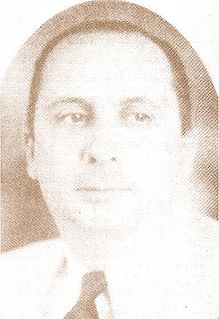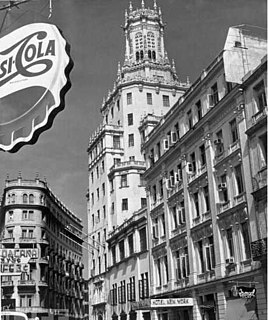The music of Cuba, including its instruments, performance and dance, comprises a large set of unique traditions influenced mostly by west African and European music. Due to the syncretic nature of most of its genres, Cuban music is often considered one of the richest and most influential regional musics of the world. For instance, the son cubano merges an adapted Spanish guitar (tres), melody, harmony, and lyrical traditions with Afro-Cuban percussion and rhythms. Almost nothing remains of the original native traditions, since the native population was exterminated in the 16th century.

Alfredo de Zayas y Alfonso, usually known as Alfredo de Zayas under Spanish naming customs and also known as Alfredo Zayas, was a Cuban lawyer, poet and political figure. He served as prosecutor, judge, mayor of Havana, secretary of the Constitutional Convention, Senator 1905, president of the Senate 1906, Vice President of Cuba 1908–1913 and President of Cuba from May 20, 1921 to May 20, 1925.

Nancy Morejón is a Cuban poet, critic, and essayist. She was a recipient of the Struga Poetry Evenings Golden Wreath Award.
Jorge Mañach y Robato was a Cuban writer and attorney, considered among the most distinguished of his time.
Cha-cha-chá is a genre of Cuban music. It has been a popular dance music which developed from the Danzón-mambo in the early 1950s, and became widely popular throughout the entire world.

Daniel Chavarría was a Uruguayan revolutionary and writer, who lived in Cuba since the 1960s.

Carlos Saladrigas Zayas was a Cuban conservative politician and diplomat.

Ramón Zaydín y Márquez Sterling (1895–1968) was a Cuban politician and Prime Minister of Cuba.

Félix Lancís Sánchez was a Cuban politician and Prime Minister of Cuba.

Manuel Antonio de Varona y Loredo was a Cuban lawyer and politician.

Leonardo Morales y Pedroso (1887–1965) was one of the most prominent Cuban architects from early 20th century.

Isaac Nicola Romero was a prominent Cuban guitarist and one of the founders of the modern Cuban Guitar School. He was also brother of Clara (Cuqui) Nicola.

Gustavo Cuervo Rubio, he was a Cuban doctor and politician.
Félix Tanco y Bosmeniel (Jan 28, 1797–1871, was a writer, poet, and novelist, better known for the first fictional story about slavery in the Americas: Petrona y Rosalía.
The guitar was the first instrument that was heard in Cuba after the conch horns, flutes and drums that the original aborigines used to play; as it was documented by Spanish chroniclers such as Bernal Díaz del Castillo.. Through the centuries, the guitar has continued to be one of the most important and cherished instruments in Cuba, both in the practice of popular music as well as in the classical music tradition. Founded by renowned professors such as Clara Romero, Isaac Nicola, Clara (Cuqui) Nicola, Carlos Molina (guitarist), and Marta Cuervo Riverón, the Cuban guitar school has acquired an excellent international reputation since the 20th century, represented by important instrumentalists and composers such as Leo Brouwer, Carlos Molina (guitarist), José Rey de la Torre, Juan Antonio Mercadal and Joaquín Clerch, among many others.
Domitila García Doménico de Coronado was a Cuban writer, journalist, editor, and professor, considered to be the first women to practice journalism in her country.

The Sociedad Económica de los Amigos del País de la Habana or Real Sociedad Patriótica de la Habana is a learned society in Havana, Cuba. It was initially organized to promote agriculture, commerce, education, and industry, modelled on the Sociedad Económica de los Amigos del País in Spain. Founding members included Diego de la Barrera, Francisco Joseph Basabe, José Agustín Caballero, Luis de Las Casas, Juan Manuel O'Farrill, Tomás Romay y Luis Peñalver, and Antonio Robledo. In its early decades the group produced publications, maintained a library in the Convento de Santo Domingo (1800-1844), and arranged educational programs. Around the 1790s the group built the Hospicio o Casa de Beneficencia in Havana.
Nancy Alonso was a Cuban biologist, university professor, and writer. She is a Alba de Céspedes Female Narrative Prize laureate, and received honorable mention in the David Short Story Prize. Among her notable books are Tirar la primera piedra (1997), Cerrado por reparación (2002) and Desencuentro (2009). Alonso is employed by Editions Bologna.

Josefina García-Marruz Badía is a Cuban poet and literary researcher. She has received numerous awards, including the National Prize for Literature (1990), Pablo Neruda Ibero-American Poetry Award (2007), and the Reina Sofía de Poesía Iberoamericana (2011).
Laura Mestre Hevia was a Cuban translator, humanist and writer. Some of her work was published, and at her death she left unpublished translations into Spanish of the works of Homer.













